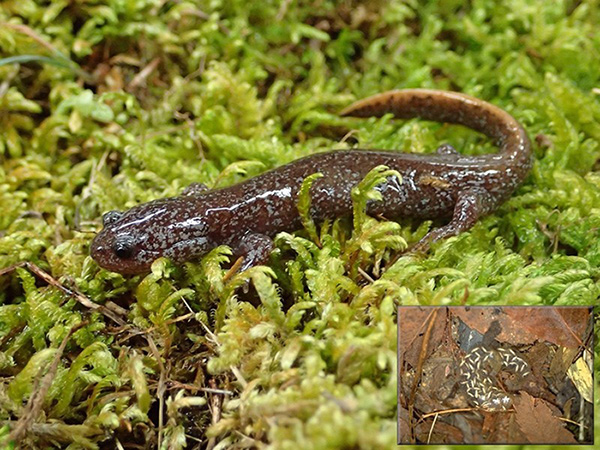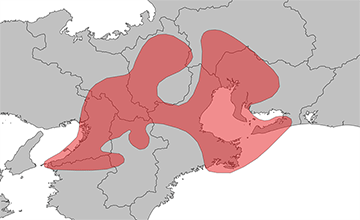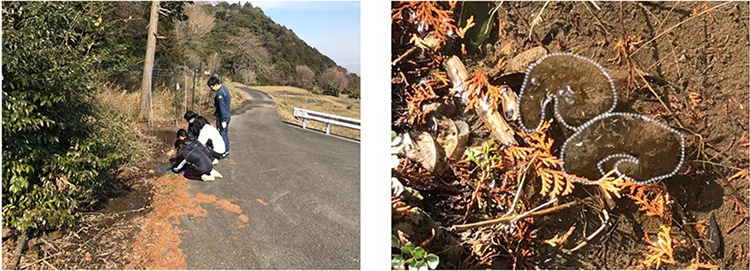A research team has successfully identified an unknown population the endangered Yamato salamander (Hynobius vandenburghi) in Gifu Prefecture, using a methodology combining GIS and eDNA analysis. This method could be applied to other critically endangered species, in addition to being utilized to locate small organisms that are difficult to find using conventional methods.

Photo credit: Koki Tsunekawa (Nature and Science Club Bioscience team leader, Gifu Senior High School 3rd grade)

The study was conducted by students from the Bioscience team in Gifu Senior High School's Nature and Science Club (which has been conducting research into the species for 13 years). They were supervised by teachers and aided by university researchers, including Professor Toshifumi Minamoto from Kobe University's Graduate School of Human Development and Environment. The project was a collaboration between Gifu Senior High School, Kobe University, Gifu University and Gifu World Freshwater Aquarium.
It has been reported that there are approximately 50 Hynobius species of salamander worldwide, around 30 of which are endemic to Japan. Hynobius vandenburghi (until recently known by its previous classification of H. nebulosus), is only found in central and western Japan, with Gifu Prefecture marking the north east limit of the species' distribution (Figure 2). However, like approximately 60% of amphibian species in Japan, it falls under the ranking of critically endangered and vulnerable species, mainly due to habitat decline*. Only three sites providing habitats for Yamato salamanders had been discovered in Gifu Prefecture up until recently.
The research team utilized a combined methodology of GIS and eDNA analysis with the aim of discovering more Yamato salamander habitats. GIS (Geographic Information System) is a spatial analysis tool that allows data and geographic information to be collected, displayed and analyzed. Environmental DNA analysis involves locating DNA of the species in the environment (in this case in water samples) to understand what kind of organisms live in that habitat.
First of all, environmental factors (such as vegetation, elevation, and gradient inclination and direction) present near the known habitats in Gifu Prefecture were identified, and this information was entered into the GIS to locate new potential habitats. This resulted in a total of five new potential sites being discovered- three in Gifu city and one site each in Kaizu and Seki cities.
Next, each site was visited and water samples were taken. Yamato salamander often lay their egg sacs in shallow water near rice paddies and wooded areas, so the water samples were taken from these environments. The samples were then analyzed for Yamato salamander eDNA. eDNA was discovered in the water from the Kaizu City site, the Seki City site and one of the Gifu City sites.
Field surveys were also conducted to find eggs or adult salamanders at each of the sites where eDNA was discovered. A single pair of egg sacs were found at the Kaizu city site (Figure 3). This lends support to the idea that the combined methodology of GIS and eDNA analysis can be successfully utilized to find new habitats of rare and elusive species like the Yamato salamander.

As this research was carried out by supervised high school students, it is anticipated that this combined methodology can be utilized not only by experts but also as a useful tool for citizen-led conservation efforts. Another advantage of the GIS and eDNA analysis method is that it requires less time, energy and funds compared to conventional field capture (locating animal specimens). This could prove invaluable for identifying and protecting the habitats of endangered species in the face of rapidly declining biodiversity worldwide.
References:
* Japanese Ministry of the Environment (2019). Red List 2019. Electronic version available at: https://www.env.go.jp/press/files/jp/111318.pdf (accessed August 28, 2019) (in Japanese)
Journal information
- Title
- "Discovery of an unrecorded population of Yamato salamander (Hynobius vandenburghi) by GIS and eDNA analysis"
DOI: 10.1002/edn3.31
- Authors
- Yusuke Sakai1, Ayane Kusakabe1, Kota Tsuchida1, Yuka Tsuzuku1, Shogo Okada1, Takuto Kitamura1, Sei Tomita2, Takahiko Mukai3, Masataka Tagami4, Masaki Takagi1, Yuichi Yaoi1, Toshifumi Minamoto2
- 1 Nature and Science Club Bioscience Team, Gifu Senior High School, Gifu, Japan
- 2 Graduate School of Human Development and Environment, Kobe University, Kobe, Japan
- 3 Faculty of Regional Studies, Gifu University, Gifu, Japan
- 4 Gifu World Freshwater Aquarium, Kakamigahara, Japan
- Journal
- Environmental DNA






